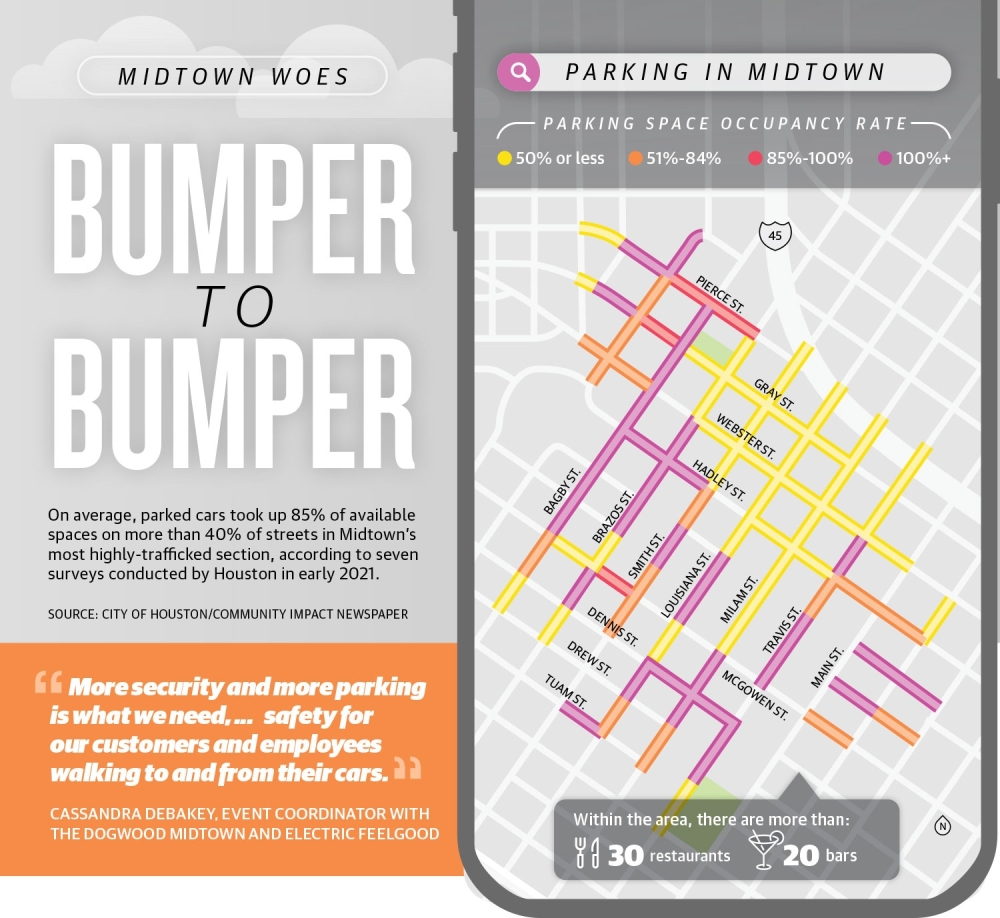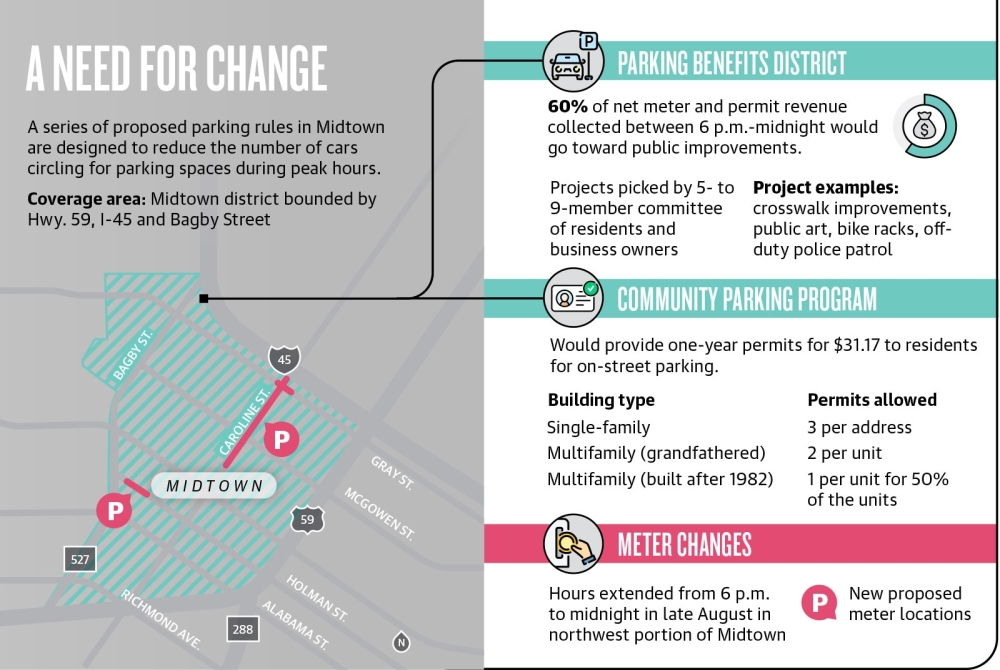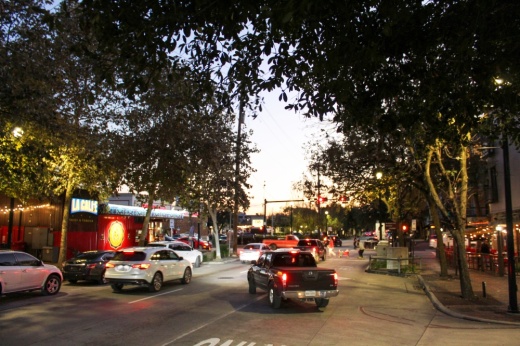When Midtown resident James Llamas hears from others about what it is like to visit Midtown, the battle for street parking is usually at the forefront of the conversation, he said. From the roof of his high-rise on Bagby Street, Llamas said he has a firsthand view of what takes place on a typical Friday or Saturday night.
“When there is not a spot to be found on the street, there are all sorts of spaces available in off-street lots and garages,” he said. “[Those spots] either aren’t available because those parking operators don’t want to try to compete with free street parking or they cost a few dollars, and people would rather cruise for the free spots.”
With more than 20 bars and 30 restaurants operating in the core of Midtown—between Bagby and Fannin streets and north of Tuam Street—parking can fill up fast. Data from seven surveys conducted in the area in early 2021 by the city of Houston showed parked cars typically take up 85% of available spaces on more than 40% of streets.
To make better use of the existing parking infrastructure, the city of Houston is looking into several new concepts, said Maria Irshad, assistant director for ParkHouston, the agency responsible for on-street parking in the city. The goal, she said, is to turn Midtown into a place where the parking system runs more efficiently, a process that has already resulted in meter hours being extended in a section of Midtown.
“Curb space is really managed through simple economics—supply and demand,” she said. “When you’ve got high demand and low supply, you’ve got to put a price on it to be able to manage that curbside.”
The parking problem

The benefits district would take 60% of the net money brought in by parking meters and permits and put it into a pot that would be used by the management district to make improvements within the district’s boundaries.
A management district is a supplemental municipal district that works alongside the city of Houston to make a wide variety of improvements in an area.
The first key step in addressing Midtown’s parking problem was taken last August, when the city approved a change in meter hours in parts of Midtown, extending them to midnight on Mondays through Saturdays. Previously, drivers could park between 6 p.m.-7 a.m. without having to pay the meter.
The question now is whether the additional meter revenue will all go back to Houston’s Parking Revenue Special Fund or if a portion of it will remain in Midtown, Irshad said. The meter hour extension has brought in about $20,000 in gross revenue per month since it was implemented, she said.
Structure and representation
The district could go before the Houston City Council for consideration in March. If approved, it would be run by a subcommittee of the MMD. Although the management district would have some of its members on the subcommittee, Llamas said Midtown’s residents and business owners would be the driving force determining how the money is spent.
The money could be spent on projects that encourage walking and biking by making it safer and easier for people to move around Midtown. Projects could include intersection safety enhancements, fixing sidewalks, additional bike racks and new bike share stations, Llamas said.
“We really have a lot of the pieces in place to be a wonderfully walkable, bikeable district, ... but some of the street infrastructure is really holding that back,” Llamas said.
Cassandra DeBakey, event coordinator with The Dogwood and Electric FeelGood, two Midtown businesses near Bagby Street, said she would like to see funding from the potential benefits district put toward security to provide additional safety for customers and employees walking to and from their cars.
Michael Lewis, the president of the Midtown Super Neighborhood No. 62—a group representing more than 1,500 residents as well as businesses and civic organizations—said he is working to make sure more super neighborhood members are represented on the subcommittee. In a Feb. 7 letter to Houston City Council members, Lewis pointed to a draft ordinance of PBD and CPP that only identified one seat for the super neighborhood on the proposed nine-person committee, which Lewis said was unacceptable.
In the letter, Lewis asked council members to support increasing the number of super neighborhood representatives on the committee to three.
"Based on the successful precedent of the Museum Park [Super Neighborhood] in securing more seats on their Advisory Committee, we worked with Park Houston and the MMD to gain consensus on the number of MSN #62 representatives on the Midtown Advisory Committee," Lewis wrote in the letter, a copy of which was provided to Community Impact Newspaper. "Without a larger voice on the committee, the MSN is concerned that more money will be spent by the MMD on items of secondary concern to our community."
Lewis said the super neighborhood wants to "vibrant and livable community that is safe and clean for residents," adding that it would prioritize quality of life enhancements related to public safety, homelessness, arts and economic development. In a vote that 68% of the super neighborhood's delegates took part in, 78% voted in favor of the PBD and Community Parking Program.
Extending meter hours and forming the benefits district follow the playbook of Donald Shoup, a research professor with the Department of Urban Planning at UCLA. In December, Shoup spoke at the Rice University Kinder Institute for Urban Research about how parking reforms can improve urban metro areas.
Parking meters were put into what Shoup described as a “commercial skid row” in Pasadena near Los Angeles with revenues going toward public services, such as rebuilding sidewalks, installing street lights and cleaning up alleyways. Once those improvements were made, residents and business owners collaborated to make more improvements, leading preservation efforts for historic buildings.
“Within three years, the sales tax revenue in the area increased five times,” Shoup said. “It created this terrific upward spiral.”
In addition to the benefits district, Irshad said the Community Parking Program would sell one-year permits to residents for $31.17 for on-street parking in the district.
There was some initial resistance to the parking permits when the Washington Avenue benefits district was established, said Mark Fairchild, president of the Rice Military Civics Club. However, once people realized they were paying to have their parking spaces protected, they started coming around, he said.
“Once people figure out what it means, they come to accept it as a net positive,” he said.
Lance Gilliam, chief of staff for District C Council Member Abbie Kamin, said Kamin's office supported measures that make it easier for residents to park. If the measures pass, the District C office is committed to working hand-in-hand with residents affected by the change to get everyone through the process while ensuring community engagement throughout the coming months, he said.
Ground zero for reform

Another piece of the long-term puzzle—combating the overreliance on cars—involves improving public transportation options, including the completion of bike connections and key expansions of the bus system run by the Metropolitan Transit Authority of Harris County.
Midtown’s parking changes are being considered as METRO is working to advance its $7 billion METRONext plan to improve public transportation citywide. Projects affecting Midtown include upgrades to the Scott Street and Westheimer Road bus corridors, which Llamas said also provides an opportunity to think about connecting the red bus lanes—which are reserved for carpooling and buses—from Westheimer to downtown Houston.
In the meantime, evidence is building that Houstonians are happy to take advantage of bike infrastructure when they feel safe doing so, Llamas said, citing growing use of the city’s bike-sharing program on the bayou greenways.
“It’s going to be an evolution,” Llamas said. “Things aren’t going to change dramatically tomorrow, but through incremental improvements, that shift will take place.”






